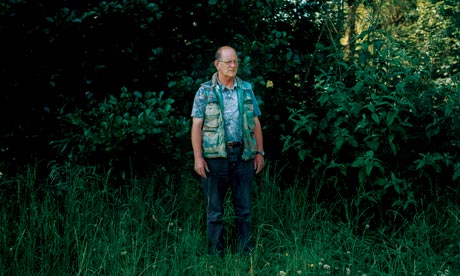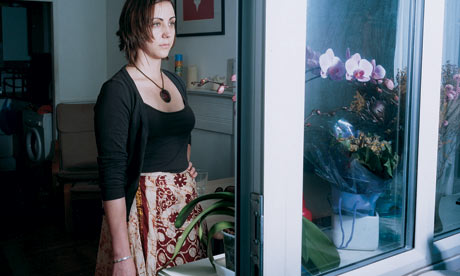Although the following article from the Guardian UK doesn’t have anything to do with the paranormal, I thought it was a good read and wanted to share it with you guys.
Many times we often focus our attention to a murderer or serial killer and often wonder about themselves and their victims. Feeling sorry for one and hatred for the other; but we never really think about the people who, because of an indirect action, unwillingly become entangled in the tragedy of the attacker and the victim.
I’m talking about people who stumble onto dead bodies. What do they do? how are they affected afterwards?
We never remember the person who makes the macabre find; much less know anything about them. What do they take with them after they discover a dead body? It can’t be the pride of making a discovery…can it? Many times we hear about people being deeply affected by what they have seen. Can it be that the energy of the scene follows them home? (I guess this turned out paranormal after all)
Full source: Guardian UK
Trevor Saunders: Discovered Gemma Adams, the first victim of the Ipswich Serial Killer to be found
Trevor Saunders: ‘I noticed something alien protruding from the water.’ Photograph: Kalpesh Lathigra
It was an unusually sunny morning in December 2006 and I was on my rounds as a volunteer fisheries warden. I was checking for blockages in Belstead Brook, a gully that runs into the river Orwell, and remember thinking how pleasant it was to hear the birds singing after days of rain.
Then I noticed something alien protruding from the water. Moving closer, I brushed some dirt away and thought it may be a mannequin. I touched the shape; it was freezing cold. I wondered if it was a human being, but I couldn’t see a head because it was covered with debris. When I shifted it, I realised I had found a dead body.
I now think of her as Gemma [Adams, the first victim of Ipswich serial killer Steve Wright to be discovered]. The body was face down, with the arms outstretched and bent at the elbows. It had been in the water for at least two weeks, which had slowed down decomposition, and I am grateful for that. Her face was on its side, her eyes were half open. She just looked like a normal person.
Having read about the missing women in the papers, I wondered if this was one of them. When I lifted away the debris, a small globule of dried blood drifted past. That really stuck in my mind. I dialled 999 and then called my boss. The police came in 15 minutes. I pointed to where I had found the body and they asked me to stay away while they got up to their knees in mud to reach her. Then the circus started. There must have been at least half a dozen police cars, plus motorbikes and the press. They set up a portable toilet and a catering van. I was there all day. I was the only member of the public allowed at the spot, because I had to show people around the lakes and the area. They used my caravan as an office. It was comforting to be part of the investigation, and it was night-time before they took Gemma away. It was a relief to me that she was now safe and dry.
I am glad I found her because it kick-started the police to finding the other women. And also I feel that from that moment Gemma was at peace. The following night I had a dream. I was at the brook and Gemma was there. She turned to me and said, “Thank you.” In fact, for the first few nights afterwards I couldn’t sleep without having a flashback to the moment I’d found her. I’m a very emotional person, even more so since this happened. I couldn’t help thinking over and over, “What makes a person do something like that?”
The police put me in touch with Victim Support, and it was enough for me just to talk to them on the phone. I am normally chirpy, but those who knew me saw I was depressed. No one can understand what it feels like unless it has happened to them.
When it came close to the first anniversary, I bought Gemma a buddleia and planted it in her name by the brook. I visit every day. I feel like I know her; she’s part of my life. It’s as though she is a friend, a very strong bond. As soon as a photo of Gemma comes on the TV, I find myself crying.
Ken Jiggins: Discovered the bodies in the ‘Essex Boys’ murders
It was a freezing cold morning in December 1995 and I had gone to help my friend Pete feed the birds at his farm in Essex. We were driving along a track when we saw a parked Range Rover, and. I went to see if it could be moved because it was blocking access to the fields. As I came closer, I saw two men in the front and thought, “Bloody hell, they aren’t half big.” The driver had one hand on the wheel and one on the gear lever, and the passenger was looking out the front with a mobile phone in his hand. From the nose up they looked normal. But the lower halves of their faces were shot off, flesh and blood hanging down like beards.
I banged on the window and got no response, and I thought, “Oh Christ!” I said to Pete, “They’ve both been shot and they’re both dead.” Pete came over, looked and said, “There’s one in the back as well.” There was no blood on the windscreen, the upholstery or anywhere else in that motor, which seemed strange. I called the police and they arrived shortly afterwards. I said to one, “I hope you have a strong stomach, because you’re going to need it.”
While they were examining the scene, we went to feed the pheasants. We weren’t in shock. I didn’t even feel a rush of adrenaline. We had done our duty, having stumbled across something that had nothing to do with us. At the time the IRA were quite lively, and we didn’t know if it was a contract killing, but I wasn’t going to get my fingerprints on the motor. We could have been in the frame for it because we were there and we owned shotguns.
The dead men turned out to be drug dealers named Tony Tucker, Craig Rolfe and Patrick Tate. Two men were convicted of all three murders.
It’s strange because the experience lasts only a few seconds. The police offered me counselling, but I’d seen pictures of dead bodies in the paper – I would rather it was me who found them than one of these old dears who walk their dogs down that lane. Although I wouldn’t want to experience that again, it’s not like finding a child or a woman. That would have affected me, as it would anyone. But it looked like a contract killing. Clinical – the doors had been shut afterwards. They didn’t deserve it, nobody does, but it happens. All I could think was, “Somebody is going to have a very bad Christmas.”
John Tucker: Discovered a drowned woman’s body in a river
It was 7am, a crisp, autumnal day in 2008, and I was walking my dogs about two miles from Carmarthen. I was heading along an old railway line that runs parallel to a river, and the water was flowing swiftly. Then I saw it: the body of a woman in shallow water, partially clothed. I couldn’t see if she had been injured, because I didn’t want to get too close – I was afraid of contaminating the area.
Initially I felt a sense of inquisitiveness and excitement. I walked this same route every day, and was very familiar with the surroundings, so I was not quite sure what I was looking at. I didn’t feel any real panic when I realised I was in the company of a dead body, but I did feel an adrenaline rush. I had a couple of minutes to weigh up exactly what I had discovered, and how she might have got there, before I called the police.
While waiting for them to arrive, I had time to reflect. I had no sense of fear, but felt sorrow for the individual and her family, and for the futility of it all. After I had dealt with the police, I felt undertones of guilt, but I don’t know why.
I don’t think I suffered any post-incident stress. I gave evidence at the inquest, and that brought back memories of discovering her, but perhaps the formality of the day suppressed the emotional aspects. The woman died as a result of drowning, and the coroner recorded an open verdict, saying there was not enough evidence to suggest suicide. The police offered me support, and their handling of my involvement in the case was exemplary.
I realise that I have been through something most people will never experience, but it touched me for less than an hour. What’s awful is that the family of the deceased will live with it for ever.
Abigail Stepnitz: found a head in a bin in San Francisco
I was a social worker in the Tenderloin district of San Francisco, an area notorious for its high numbers of homeless people and drug users. One sunny day in March 2005 I was asked to accompany some colleagues on a trip to the park with a group of pre-school kids. The children were playing happily when I heard a commotion on a street corner near a large trash can. As I approached, a small group of homeless men ran away. It was a day when everyone had just got their general assistance cheque [the equivalent of a benefits payment] and was spending it on their poison of choice. I thought they must be high or drunk.
I heard rattling noises coming from the trash can and decided to look inside in case a person was trapped in there. It was probably just rats, I thought. But as I peered in I saw a severed head perched on a pile of rotting food. My first thought was, “We can’t let the kids walk back this way.” I was terrified at the thought that the rest of the body – or, indeed, the murderer – might be around somewhere.
I don’t think the head had been in there for long. It was a man’s face, lying on its side, its long blond hair mingling with the rotting chicken, sour milk and nappies. I couldn’t tell if he had been beaten to death because, like him, most homeless people in that area have cuts and bruises on their faces, and teeth that are falling out.
I said something like, “Jesus fucking Christ” and put the lid down. I was just a couple of steps from the sidewalk and I ran on to it. I panicked. I called the police, and warned the childcare centre not to take the kids anywhere near the area. These cops don’t care – they police a park where the popular way of getting rid of homeless people is to douse them in gasoline and set them on fire.
I searched the local papers for any mention of the murder, but found nothing. I followed it up with the police, but didn’t hear back. I was worried we might have a body-hacking serial killer on the loose. They didn’t seem to care.
I never found out who he was, and if I were to make a list of my 10 worst experiences, this probably wouldn’t be on it. In some ways, it is actually more distressing to step over the people still suffering on those streets, the ones you see lying in their own blood.
Full source: Guardian UK
3 comments






